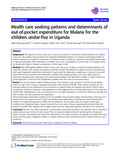| dc.description.abstract | The objectives of this study were to assess the patterns of treatment seeking behaviour for children under five with malaria; and to examine the statistical relationship between out-of-pocket expenditure (OOP) on malaria treatment for under-fives and source of treatment, place of residence, education and wealth characteristics of Uganda households. OOP expenditure on health care is now a development concern due to its negative effect on households’ ability to finance consumption of other basic needs.The 2009 Uganda Malaria Indicator Survey was the source of data on treatment seeking behaviour for under-five children with malaria, and patterns and levels of OOP expenditure for malaria treatment. Binomial logit and Log-lin regression models were estimated. In logit model the dependent variable was a dummy (1=incurred
some OOP, 0=none incurred) and independent variables were wealth quintiles, rural versus urban, place of treatment, education level, sub-region, and normal duty disruption. The dependent variable in Log-lin model was natural logarithm of OOP and the independent variables were the same as mentioned above.Five key descriptive analysis findings emerge. First, malaria is quite prevalent at 44.7% among children below the age of five. Second, a significant proportion seeks treatment (81.8%). Third, private providers are the preferred option for the under-fives for the treatment of malaria. Fourth, the majority pay about 70.9% for either consultation, medicines, transport or hospitalization but the biggest percent of those who pay, do so for medicines (54.0%). Fifth, hospitalization is the most expensive at an average expenditure of US$7.6 per child, even though only 2.9% of those that seek treatment are hospitalized. The binomial logit model slope coefficients for the variables richest wealth quintile, Private facility as first source of treatment, and sub-regions Central 2, East central, Mid-eastern, Mid-western, and Normal duties disrupted were positive and statistically significant at 99% level of confidence. On the other hand, the Log-lin model slope coefficients for Traditional healer, Sought treatment from one source, Primary educational level, North East, Mid Northern and West Nile variables had a negative sign and were statistically significant at 95% level of confidence.The fact that OOP expenditure is still prevalent and private provider is the preferred choice, increasing public provision may not be the sole answer. Plans to improve malaria treatment should explicitly incorporate efforts to protect households from high OOP expenditures. This calls for provision of subsidies to enable the private sector to reduce prices, regulation of prices of malaria medicines, and reduction/removal of import duties on such medicines. | en_US |

